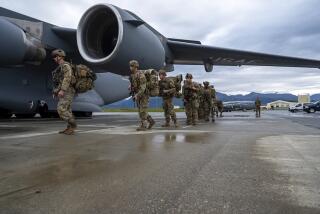Military Command Targets Drug Cartels : Border: NORAD is eager, but lack of information and radar stymies effort to stop smugglers, general says.
- Share via
As a recent entrant in the battle against drugs, the North American Aerospace Defense Command is hampered by a lack of information on drug-trafficking patterns and inadequate radar, a top official said Thursday.
But the joint U.S.-Canada force is willing and able to help in detecting drug smugglers, and “the stories you read about us not being interested in the job is just a lot of hooey,” said Gen. John L. Piotrowski, commander of the NORAD Command and the U.S. Space Command, headquartered at Peterson Air Force Base in Colorado Springs.
“Resources are already paid for, and we are just putting them to work. . . . Fighter pilots love to fly, whether it’s chasing Soviet aircraft or . . . chasing drug smugglers,” Piotrowski said in a speech to the World Affairs Council of San Diego.
The command, formed in 1957, patrols and protects the airspace over the two countries as well as the area over the U.S.-Mexico border. For two decades, NORAD targeted the Soviet Union as its main threat. But last year, under congressional mandate, the command redefined its role to include drug cartels. Though it has no authority to make arrests, the force, with fighter jets available from 29 bases around the clock, can detect and monitor smugglers’ movements.
Some experts say the new dual role of the military, particularly in view of glasnost , is an appropriate use of existing manpower and technology.
“Providing surveillance and disseminating information is suitable--they have to do training anyway, they have to fly airplanes anyway,” said Myron Hura, a military analyst with the Rand Corp. “They might as well incorporate that into operations.”
From April through June, NORAD assisted in apprehending 14 aircraft that were loaded with drugs, Piotrowski said at the luncheon meeting at the Admiral Kidd Club. In pursuing these smugglers, who were caught with $200 million to $800 million worth of drugs, the command spent $1.6 million in fuel, he said.
Those three months, however, proved to be the command’s best. For the year, NORAD intercepted “hundreds” of aircraft, but only about 20 were carrying drugs, he said.
NORAD’s radar is designed to snare the high- and fast-flying Soviet planes. But drug cartels frequently use light single- and twin-engine aircraft that fly no more than 3,000 feet above ground.
“What we don’t have is good surveillance,” Piotrowski said. “We’ve got lots of holes, gaping holes at low altitude.”
In 1987, when West German Mathias Rust landed in Moscow’s Red Square, it served as a reminder to U.S. officials of their own nation’s vulnerability--an absence of ground radar from Vancouver, in southwest Canada, to the Alaska panhandle.
“Could it happen here? Yes,” Piotrowski said.
But steps have been taken to shore up the system. A facility is being built at Rimrock in San Bernardino County. And officials have proposed a space facility that could track aircraft over one-third of the Earth, he said.
Radar holes are only one problem in chasing drug smugglers, who have ample funds for sophisticated technology to help them dodge pursuers.
But even relatively inexpensive equipment such as a $280 Spybuster, a device that helps speeding motorists escape detection, works for smugglers, Piotrowski said. “We have technology working against us.”
In addition, the military is hampered by a lack of information about smugglers’ flight patterns and their preference for day or night flights.
The military has forged a tepid bond with law enforcement agencies.
“They look upon us as another group of guys with large appetites for military resources,” said Piotrowski, who emphasized that he does not believe that the military needs new equipment, beyond the investments already under way, to combat drugs.
And Piotrowski believes his 15,000-member force has made a dent. As evidence, he points to smugglers’ changing strategies: more pedestrian carriers and airdrops to speedboats.
Tracking smugglers enhances the military’s prime mission of defending the nation, he said. “Anything we do makes us more effective against the enemy trying to penetrate our shores.”
More to Read
Sign up for Essential California
The most important California stories and recommendations in your inbox every morning.
You may occasionally receive promotional content from the Los Angeles Times.













